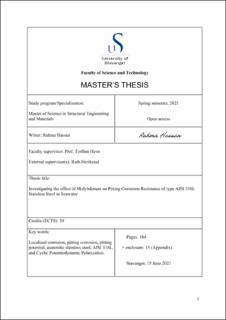| dc.description.abstract | This master thesis focuses on how long it is possible to expose AISI 316L stainless steel to seawater before pitting corrosion occurs. Exposure time is of interest because seawater ingress can cause pitting corrosion in pipelines during pipelaying and tie-in operation. The exposure time where the pitting corrosion occurs in pipelines must be studied to prevent or minimize pitting corrosion. This study investigates the effect of different molybdenum (Mo) content on the corrosion properties of stainless steel. The effect of various temperature and time conditions are included when evaluating the effect of Mo content.
This study investigated the effect of variation in Mo content of AISI 316L stainless steel by conducting different experiments. A long-term exposure test was performed to determine the critical exposure time for pitting at room temperature and 7 degrees. The difference in pitting corrosion resistance between AISI 316L with 2,5% Mo and AISI 316L with 2,0% Mo was investigated using Open Circuit Potential measurements. A Cyclic Potentiodynamic Polarization experiment was conducted to investigate the tendency of pitting occurrence for specimens of AISI 316L 2,5% Mo and AISI 316L 2,0% Mo. Corrosion parameters were obtained from the Cyclic Polarization curves to evaluate the pitting corrosion behavior of specimens with different Mo content. To compare the corrosion resistance of the two alloys, the pitting potential of exposed and unexposed samples was found. The pitting potential of unexposed samples was obtained from the Cyclic Polarization curves to investigate the effect of Mo content at 6 degrees, room temperature, and 40 degrees. At the same time, the pitting potential of exposed coupons from the long-term exposure test was found at room temperature.
The results from the long-term exposure test indicated that the 2,5% Mo alloy has higher pitting corrosion resistance than the 2,0% Mo alloy. 15 out of 20 coupons made of 2,0% Mo alloy showed signs of pitting corrosion on the surface. When the experiments were done after 100 days, no coupon of 2,5% Mo alloy had any corrosion products on the surface. Open circuit potential measured varied throughout the long-term exposure test.
The results from the pitting potential of exposed samples showed that the samples of 2,0% Mo alloy gave a higher pitting potential than the samples of 2,5% Mo alloy. The results obtained from the pitting potential of unexposed samples showed that the pitting potential increased when the temperature decreased. Specimens of 2,0% Mo alloy have a higher average pitting potential than specimens of 2,5% Mo alloys, which indicates that it has the most resistance to pitting corrosion. These findings are contrary to previous studies, which have suggested that the pitting potential increases with Mo. This is also contrary to the long-term exposure test, which showed that 2,5% Mo in fact had more resistance to pitting.
The Cyclic Potentiodynamic Polarization implied that differences in alloying content affect the corrosion parameters. 2,0% Mo alloy has a more positive average open circuit potential (Ecorr), pitting potential (Epit), repassivation potential (Erep), passivation range (Epit-Erep), and nucleation resistance (Epit-Ecorr). Despite having the most positive average corrosion parameters, the pitting susceptibility factor of 2,0% Mo alloy is lower than 2,5% Mo alloy. | |
